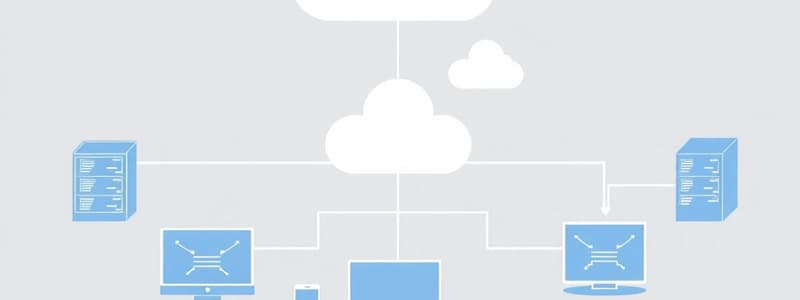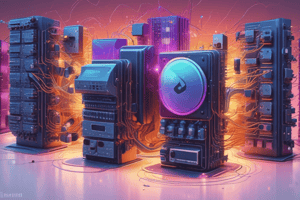Podcast
Questions and Answers
A distributed system appears to its users as a single coherent ______.
A distributed system appears to its users as a single coherent ______.
system
A distributed system operates on multiple, autonomous ______ elements.
A distributed system operates on multiple, autonomous ______ elements.
processing
In a distributed system, computers are linked by a ______.
In a distributed system, computers are linked by a ______.
network
A defining feature of distributed systems is that they do not share primary ______.
A defining feature of distributed systems is that they do not share primary ______.
Resource and data sharing in distributed systems can include ______, databases, and multimedia servers.
Resource and data sharing in distributed systems can include ______, databases, and multimedia servers.
The loss of some instances can be hidden in terms of ______ and reliability.
The loss of some instances can be hidden in terms of ______ and reliability.
In a distributed system, the system grows with demand, such as adding extra ______.
In a distributed system, the system grows with demand, such as adding extra ______.
Distributed systems can provide huge power in terms of ______ and memory.
Distributed systems can provide huge power in terms of ______ and memory.
One characteristic of centralized systems is that they have a single point of ______.
One characteristic of centralized systems is that they have a single point of ______.
Heterogeneity in distributed systems refers to differences in ______, platforms, languages, and management.
Heterogeneity in distributed systems refers to differences in ______, platforms, languages, and management.
One of the problems of distribution is that clients must not disturb each other's ______.
One of the problems of distribution is that clients must not disturb each other's ______.
In distributed systems, coordination is achieved through ______ passing.
In distributed systems, coordination is achieved through ______ passing.
Distributed systems may fail independently due to network faults, isolating computers that are still ______.
Distributed systems may fail independently due to network faults, isolating computers that are still ______.
A distributed system is often organized by a layer of software called ______ that extends over multiple machines.
A distributed system is often organized by a layer of software called ______ that extends over multiple machines.
A key goal of a distributed system is to make resources ______ for users.
A key goal of a distributed system is to make resources ______ for users.
A distributed system should provide ______ transparency, hiding the fact that resources are distributed across multiple computers.
A distributed system should provide ______ transparency, hiding the fact that resources are distributed across multiple computers.
In a distributed system, ______ transparency allows multiple processes to operate concurrently without interference.
In a distributed system, ______ transparency allows multiple processes to operate concurrently without interference.
______ transparency allows resources to be accessed without knowledge of their physical or network location.
______ transparency allows resources to be accessed without knowledge of their physical or network location.
Replication transparency enables the use of multiple instances of resources to increase ______ and performance.
Replication transparency enables the use of multiple instances of resources to increase ______ and performance.
A distributed system should be ______ and scalable to accommodate growth and varying loads.
A distributed system should be ______ and scalable to accommodate growth and varying loads.
Failure transparency enables users and applications to complete their tasks despite the failure of ______ or software components.
Failure transparency enables users and applications to complete their tasks despite the failure of ______ or software components.
The server for Z2 will return the address of the server for zone ______, which is capable of handling the last part of the name.
The server for Z2 will return the address of the server for zone ______, which is capable of handling the last part of the name.
Replication is used across a distributed system to increase ______ and for load balancing.
Replication is used across a distributed system to increase ______ and for load balancing.
Caching, which is a special form of ______, reduces communication latency.
Caching, which is a special form of ______, reduces communication latency.
False assumptions made by first-time developers include that the network is ______.
False assumptions made by first-time developers include that the network is ______.
There are three types of distributed systems: Distributed Computing Systems, Distributed Information Systems, and Distributed ______ Systems.
There are three types of distributed systems: Distributed Computing Systems, Distributed Information Systems, and Distributed ______ Systems.
Cluster Computing consists of a collection of similar workstations or PCs closely connected by means of a high-speed ______.
Cluster Computing consists of a collection of similar workstations or PCs closely connected by means of a high-speed ______.
Grid Computing is defined as 'Resource sharing and coordinated problem solving in dynamic, multi-institutional ______ organizations.'
Grid Computing is defined as 'Resource sharing and coordinated problem solving in dynamic, multi-institutional ______ organizations.'
A master node in a cluster computing system runs a middleware and ______ other compute nodes.
A master node in a cluster computing system runs a middleware and ______ other compute nodes.
The problem is mainly related to ______ limitations in the capacity of servers and networks.
The problem is mainly related to ______ limitations in the capacity of servers and networks.
One solution to the problem is ______ communication latencies.
One solution to the problem is ______ communication latencies.
______ involves taking a component, splitting it into smaller parts, and spreading those parts across the system.
______ involves taking a component, splitting it into smaller parts, and spreading those parts across the system.
The Internet Domain Name System (DNS) is an excellent example of ______.
The Internet Domain Name System (DNS) is an excellent example of ______.
For interactive applications, it's suggested to move part of the job to the ______.
For interactive applications, it's suggested to move part of the job to the ______.
In the context of the DNS, resolving a name means returning the ______ of the associated host.
In the context of the DNS, resolving a name means returning the ______ of the associated host.
The DNS name space is hierarchically organized into a tree of ______.
The DNS name space is hierarchically organized into a tree of ______.
Constructing requesting applications that use only ______ communication avoids waiting for responses.
Constructing requesting applications that use only ______ communication avoids waiting for responses.
Globus is a software system for ______ Computing.
Globus is a software system for ______ Computing.
To let applications communicate directly with each other, we refer to ______ Application Integration (EAI).
To let applications communicate directly with each other, we refer to ______ Application Integration (EAI).
A transaction either happens completely or not at all; this is referred to as ______.
A transaction either happens completely or not at all; this is referred to as ______.
In a transaction, the amount of money in the bank must be consistent; this is known as ______.
In a transaction, the amount of money in the bank must be consistent; this is known as ______.
If two or more transactions are running concurrently, they must be ______ to not interfere with each other.
If two or more transactions are running concurrently, they must be ______ to not interfere with each other.
Once a transaction commits, the changes are ______.
Once a transaction commits, the changes are ______.
Mobile and embedded computing devices are described as small, battery-powered, ______, and with a wireless connection.
Mobile and embedded computing devices are described as small, battery-powered, ______, and with a wireless connection.
For pervasive applications, a device should ______ contextual changes in its environment.
For pervasive applications, a device should ______ contextual changes in its environment.
Flashcards
Distributed System
Distributed System
A collection of independent computers that appear to users as a single, integrated system.
Resource Sharing
Resource Sharing
A system's ability to share resources and data across multiple computers, like printers, databases, or servers.
Characteristics of Distributed Systems
Characteristics of Distributed Systems
A distributed system is designed to be built on many computers, each having its own failure modes, linked by a network, and operating concurrently with independent clocks.
Autonomous Machines
Autonomous Machines
Signup and view all the flashcards
Single System View
Single System View
Signup and view all the flashcards
Scalability
Scalability
Signup and view all the flashcards
Availability
Availability
Signup and view all the flashcards
Extensibility
Extensibility
Signup and view all the flashcards
Performance
Performance
Signup and view all the flashcards
Centralized System
Centralized System
Signup and view all the flashcards
Multiple Points of Failure
Multiple Points of Failure
Signup and view all the flashcards
Partial Failure
Partial Failure
Signup and view all the flashcards
Middleware
Middleware
Signup and view all the flashcards
Distribution Transparency
Distribution Transparency
Signup and view all the flashcards
Location Transparency
Location Transparency
Signup and view all the flashcards
Concurrency Transparency
Concurrency Transparency
Signup and view all the flashcards
Replication Transparency
Replication Transparency
Signup and view all the flashcards
Failure Transparency
Failure Transparency
Signup and view all the flashcards
Fault Tolerance
Fault Tolerance
Signup and view all the flashcards
Hiding Communication Latencies
Hiding Communication Latencies
Signup and view all the flashcards
Asynchronous Communication
Asynchronous Communication
Signup and view all the flashcards
Synchronous Communication
Synchronous Communication
Signup and view all the flashcards
Moving Job to Client
Moving Job to Client
Signup and view all the flashcards
Distribution
Distribution
Signup and view all the flashcards
Internet Domain Name System (DNS)
Internet Domain Name System (DNS)
Signup and view all the flashcards
DNS Zone
DNS Zone
Signup and view all the flashcards
Resolving a Name
Resolving a Name
Signup and view all the flashcards
Zone Server
Zone Server
Signup and view all the flashcards
Replication
Replication
Signup and view all the flashcards
Caching
Caching
Signup and view all the flashcards
Consistency Problems
Consistency Problems
Signup and view all the flashcards
Cluster Computing
Cluster Computing
Signup and view all the flashcards
Grid Computing
Grid Computing
Signup and view all the flashcards
Distributed Computing Systems
Distributed Computing Systems
Signup and view all the flashcards
What is Globus?
What is Globus?
Signup and view all the flashcards
What is a Distributed Information System?
What is a Distributed Information System?
Signup and view all the flashcards
What is the lowest level of interoperability in a distributed system?
What is the lowest level of interoperability in a distributed system?
Signup and view all the flashcards
What is Enterprise Application Integration (EAI)?
What is Enterprise Application Integration (EAI)?
Signup and view all the flashcards
What are transaction processing system primitives?
What are transaction processing system primitives?
Signup and view all the flashcards
What are the properties of Transactions?
What are the properties of Transactions?
Signup and view all the flashcards
What does 'Atomic' mean in ACID properties?
What does 'Atomic' mean in ACID properties?
Signup and view all the flashcards
What does 'Consistent' mean in ACID properties?
What does 'Consistent' mean in ACID properties?
Signup and view all the flashcards
Study Notes
Introduction to Distributed Systems
- Distributed systems are collections of independent computers appearing as a single coherent system to users.
- This has hardware and software aspects.
- Hardware: autonomous machines
- Software: a single system view for users.
- A system is "a complex whole; a set of connected parts; an organized assembly of resources and procedures (collection of ...) united and regulated by interaction or interdependence to accomplish a set of specific functions."
Goals of a Distributed System
- Making resources accessible: Connect users to resources (printers, computers, storage facilities, data, files, and web pages). Reasons include economics, e-commerce, and collaboration.
- Distribution transparency: Hide the distributed nature of resources and processes across multiple computers.
- Openness: Enables flexibility and extensibility to configure system components and add/replace existing ones. This necessitates well-defined interfaces and interoperability between different components.
- Scalability: Enable the system to handle growth in users and resources (size, geographically, and administratively). Problems include overloading and communication complexities as well as administrative complexity.
- Scalability techniques include hiding communication latency, distribution, and replication.
Types of Distributed Systems
- Three types:
- Distributed Computing Systems
- Distributed Information Systems
- Distributed Pervasive/Embedded Systems.
- Distributed Computing Systems (used for high performance computing)
- Two types: A. Cluster Computing: - A collection of similar workstations or PCs connected by a high-speed LAN. - Each node runs the same operating system. - Used for parallel programming where a program is run in parallel on multiple machines. B. Grid Computing: - A system that shares resources and coordinates problem-solving across multiple institutions. - A high degree of heterogeneity (different hardware, operating systems, networks, and security policies). - Globus is a software system for Grid Computing.
- Distributed Information Systems:
- Problem: many networked applications have interoperability issues
- Solutions at lowest level: Wrapping multiple requests into a single distributed transaction, or letting applications directly interact (Enterprise Application Integration).
- Distributed Pervasive Systems: Includes mobile and embedded computing devices.
- Requirements: Embrace contextual changes, encourage ad-hoc composition, and recognize sharing as a default.
- Examples: Home Systems, Electronic Health Care Systems, and Sensor Networks
Problems of Distribution
- Concurrency and Security: prevent clients disturbing each other
- Privacy: prevent unwanted communications (e.g., spam, cookies)
- Partial failure: dealing with errors, not knowing where the errors come from
- Location, Migration, Replication: enabling clients to find their servers
- Heterogeneity: managing hardware, platforms, languages, and management aspects
Transparency in a Distributed System
- Access transparency: Enable local and remote resources using identical operations.
- Location transparency: Enables access to resources regardless of their physical or network location.
- Concurrency transparency: Enables concurrent processes using shared resources without interfering with each other.
- Replication transparency: Enables multiple resource instances without users or application programmers knowing about them.
- Failure transparency: Conceals component failures, keeping applications functional.
- Mobility transparency: Allows movement of resources and clients within the system without affecting user operations.
- Performance transparency: Allows system reconfiguration to improve performance based on workload.
- Scaling transparency: Allows system and application scaling without affecting the system structure or application algorithms.
Pitfalls When Developing Distributed Systems
- Assume network reliability, security, homogeneity, constant topology, zero latency, infinite bandwidth, or single administrator, despite non-distributed features.
Transaction Processing Systems
- Application special primitives are needed. Consider database to program transactions (supplied by underlying distributed systems or systems languages).
- Distributed systems may require different techniques based on application types (using procedure calls, ordinary statements, etc.).
- Need a way to "roll back" when a transaction isn't completed.
- Transaction properties (ACID):
- Atomic: indivisible operations
- Consistent: system invariants are not violated
- Isolated: concurrent transactions don't affect each other
- Durable: permanent changes.
Studying That Suits You
Use AI to generate personalized quizzes and flashcards to suit your learning preferences.




